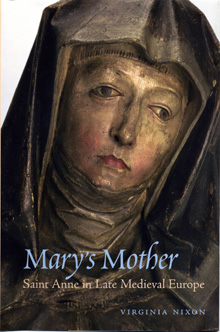New book examines popularity of St. Anne

Virginia Nixon has just published a book called Mary’s Mother: Sainte Anne in Late Medieval Europe.
In an e-mail interview, Nixon said, “I think my attraction to the medieval period goes back to reading Grimm’s fairy tales as a child. The setting of these, both text and illustrations, was usually medieval. I've loved the Middle Ages as far back as I can remember.”
St. Anne, usually thought of as the mother of Mary, the mother of Jesus, was in fact not a biblical figure. Her name first appears in an apocryphal “infancy gospel” in the second century. However, it was in the late medieval period that St. Anne really took off as a cult figure in her own right.
Nixon’s book is about the popularity of St. Anne as a devotional figure, and what it tells scholars about the way Europeans thought during that period.
“The heightened enthusiasm St. Anne enjoyed in the late 15th century didn’t simply arise, it was created by the consciously planned activities of specific groups and individuals,” she said in her e-mail. In such social phenomena “there is almost always an economic factor of some kind, not in a crude causal way, but it’s usually there in one form or another.”
She said her work fits in with a tendency in art history to understand the art of a time and place by seeing it in its milieu.
“I'm interested in going further in trying to understand medieval people's relationship with works of art. I did an article a couple of years ago analyzing the significance of the striking compositional differences in two works by the same early 16th century Augsburg artist, one done for an elite patron, the other for an illiterate viewer.”
Her book also conforms to medieval scholarship in terms of regional specificity. “One can't simply talk about the Middle Ages,” she explained.
“With St. Anne, for example, there are major differences among German cities, not to speak of the differences between different regions and countries. “
Nixon did her MA in art history at Concordia, but on a quite different subject, a 19th-century Quebec artist called Antoine-Sebastien Falardeau, who made a successful career as an Old Master copyist in Florence.
She switched to medieval German sculpture when she started her PhD. She has taught art history for 25 years at Concordia’s Liberal Arts College, and now teaches music history there as well.
Mary’s Mother was launched last month at the McGill bookstore, and Nixon reports with pleasure that many copies were sold. It is available there and at the Concordia bookstore.